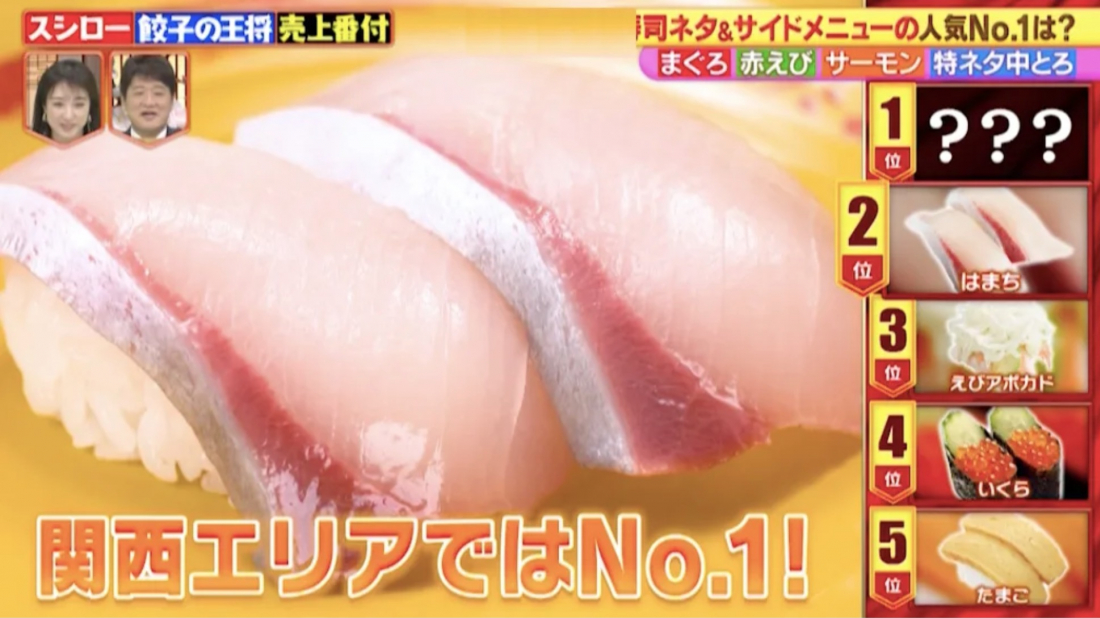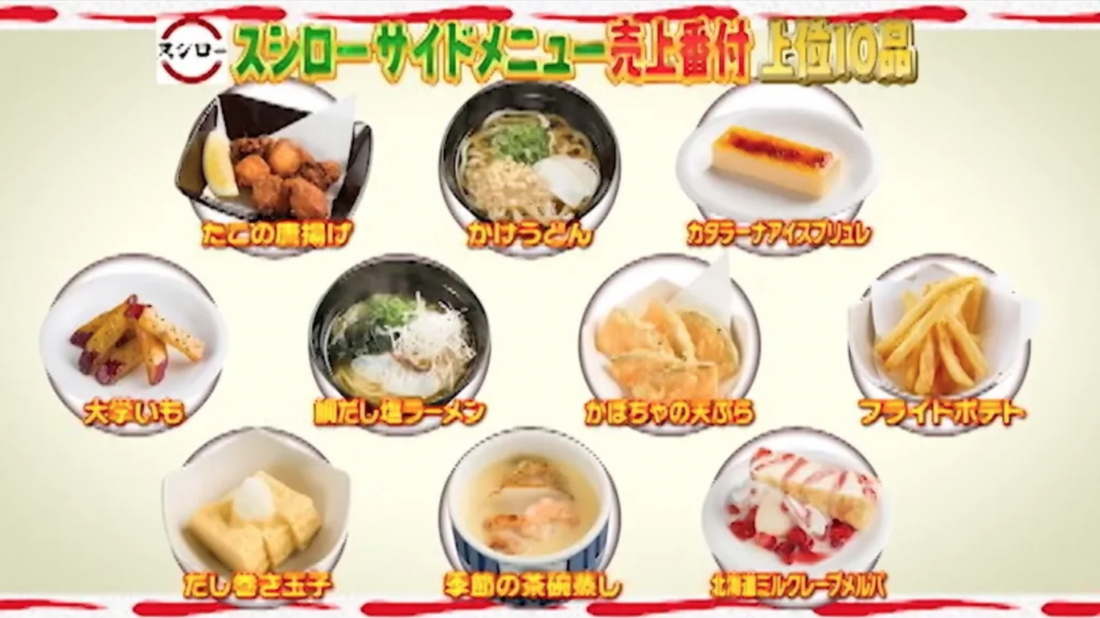CONTENTS
Announced on a recent TV show, sushi-lovers may be interested to find out what everybody’s favorite Sushiro items are!
Sushiro is one of Japan's most popular conveyor belt sushi chains, with close to 600 restaurants spread across all 47 prefectures, and a burgeoning takeout operation to boot. Sushiro is often ranked as Japan's #1 conveyor belt sushi joint, and it's no stretch to say that they serve a lot of sushi to a lot of hungry customers across Japan. So when a recent program broadcast on Fuji Television Network revealed which kinds of sushi are fan favorites, we were eager to find out. Just what are Sushiro's top 5 sushi toppings, and top 5 non-sushi offerings?
Sushiro’s Sushi Top 5
Here they are, Sushiro's top-selling sushi options! The TV show began by showing Sushiro's top 10 sushi varieties on screen, and the selection included plenty of classic nigiri sushi, some more creative selections, and even some toppings that are probably popular with kids. From that top 10, the top 5 ranking was announced as follows:
1st Place: Maguro (まぐろ, tuna)
2nd Place: Hamachi (はまち, amberjack/yellowtail)
3rd Place: Ebi-Avocado (えびアボカド, shrimp-avocado)
4th Place: Ikura (いくら, salmon roe)
5th Place: Tamago (たまご, tamagoyaki egg omelet)
The first real surprise for many viewers was the high ranking of tamago sushi. Since the eggs used to make tamagoyaki are a significantly cheaper ingredient than sushi-grade fish, many customers tend to avoid ordering it at all-you-can-eat restaurants or places like Sushiro, where it costs the same as many fish options. Why fill up on cheap ingredients when the fish is a better bang for your buck? But surveyed customers agreed that the soft, layered texture of Sushiro's tamagoyaki made it worth ordering, and was a regular part of their meals there. Diners also commented on the ikura (salmon roe) sushi, saying the eggs used in the sushi were high quality, and the quantity didn't feel stingy either. And when it came to the shrimp and avocado sushi, ranked in third place, not only did customers appreciate the creative combination, but Sushiro says that the shrimp is fresh-caught and cooked without ever being frozen, maintaining the shrimp's fresh, sweet flavor.
Hamachi sushi is made with a fish called yellowtail or Japanese amberjack, specifically when the fish is caught young. (Once the fish grows to adulthood, it's referred to as "buri" instead!) Hamachi lovers say that the fish has a delicious texture and unique umami, and that it almost melts in your mouth, and Sushiro explained that they ensure freshness by contracting with a fish farm to deliver the young fish the same day they're caught.
While Hamachi is ranked #2 nationally, for Sushiro shops in Japan's western Kansai region, it's actually #1!
Despite the overwhelming popularity of salmon sushi in many parts of the world, it's nowhere near the #1 spot in Japan. That place is taken by tuna, or maguro sushi. For their maguro, Sushiro uses a cut of tuna called the "tenmi" (天身), a part of the red meat close to the spine that is literally called "heavenly."
It turns out that while Sushiro buys the entire fish to control costs, only select portions of the fish can be used for sushi. To keep it all from going to waste, the rest of the fish is boiled down and used as the base of Sushiro's soup broth. They actually use it to serve dishes like ramen alongside their sushi! By keeping the cost down to just 100 yen since all the way back in 1996, maguro has become a natural favorite at Sushiro.
Wait, but What About Salmon?
Looking at the top 5 ranking, you might be thinking that something important seems to be missing. Where's the salmon? In much of the world, including plenty of Western countries and also places like Taiwan, salmon sushi is a serious contender for that #1 spot in terms of popularity. In Japan, however, despite salmon's long-lived popularity as a cooked fish, in raw form it has only become a common sushi topping in more recent decades. But observant readers may have noticed that while salmon didn't make it into the top 5 ranking for Sushiro, it did in fact make it into the lower half of the top 10!
Sushiro’s Side Dish & Dessert Top 5
While the sushi ranking might be the star of the show, part of the fun of a visit to Sushiro is all the other side dishes and desserts that they offer with the sushi. If you only like sushi in moderation, or you want to grab a meal at Sushiro with a friend who doesn't like raw fish, this ranking might just come in handy! All of the menu items that made it into this top 10 ranking have annual sales of more than 10 billion yen (over 90 million USD), and the cream of the crop are as follows:
1st Place: Chawanmushi (茶碗蒸し, savory egg custard)
2nd Place: French Fries
3rd Place: Udon (かけうどん)
4th Place: Tai-dashi Ramen (鯛だし塩ラーメン, ramen with sea bream and salt broth)
5th Place: Catalana Ice Brûlée (カタラーナアイスブリュレ, ice cream brûlée)
Coming in at 5th place, you may be wondering "what on Earth is Catalana Ice Brûlée?" The dessert appears to be based on crema catalana, a Catalan dessert extremely similar to crème brûlée, except that Sushiro's rendition uses a base of ice cream instead of custard or pudding. The crispy layer on top is caramelized to order, giving the dessert a cold creamy inside under a caramelly, warm, and fragrant upper. For the ramen in 4th place, on the other hand, the soup is prepared in advance by using the sea bream parts left over after the meat has been cut up for sushi, paired with scallops for a fish-and-seafood ramen that Sushiro fans have been known to call better than the soup from a ramen shop.
The restaurant's plain, simple bowls of udon have made it up to #3 in the sides and desserts ranking, which is particularly impressive because this menu item is only available on weekdays! But Sushiro offers the dish in hopes of pulling in customers for weekday lunchtime, and keeps the price of the udon down to an impressively low 130 yen.
Sushiro's second most popular side is just a good old dish of French fries, and while we might not think of fries as the ideal complement to fresh raw fish, the power of fried potatoes is just too much to resist, no matter what the meal may be. Given the cutesy nickname "potero" by the young customers who often order them, Sushiro's fries are made to order instead of just being set out on the conveyor belt, to make sure they arrive at the table hot and crispy.
Finally, the number one side dish at Sushiro is a Japanese classic that many foreign visitors might be seeing for the first time: chawanmushi. Sushiro's seasonal chawanmushi is a creamy, eggy custard flavored with savory broth and filled with ginkgo nuts, seafood, and other seasonal ingredients. It may sound a bit odd to those who have never tried it, but this warm dish is full of comforting, mild flavors, and Sushiro prepares the ingredients and steams each cup on-site, making it a popular option for diners looking for a bite of hot food. They sell almost 21 million cups of the custard in a year!
What Would Your Ranking Look Like?
Looking at what dishes are purchased most frequently by diners at Sushiro, it's hard not to imagine what rankings might be at other sushi chains, at restaurants in other countries, or even what your own personal ranking might be. Does Sushiro's actual sales ranking match up with your own preferences, or do your own tastes veer far from that of the average Japanese diner? Let us know!
For more info and updates from Japan, check Japankuru for new articles, and don't forget to follow us on Twitter, Instagram, and Facebook!
Details
NAME:Sushiro (スシロー)
The latest news from Japan - learn what's new in the land of the rising sun, from an international group right on the scene.












 >> Find out more at Japankuru.com! (link in bio)
#
>> Find out more at Japankuru.com! (link in bio)
#





 The Robot Restaurant is gone, but the Samurai Restaurant is here to take its place. Check it out, and don't forget your coupon!
The Robot Restaurant is gone, but the Samurai Restaurant is here to take its place. Check it out, and don't forget your coupon!
 신주쿠의 명소 로봇 레스토랑이 사무라이 레스토랑으로 부활! 절찬 쿠폰 발급중
신주쿠의 명소 로봇 레스토랑이 사무라이 레스토랑으로 부활! 절찬 쿠폰 발급중
 18歲以上才能入場的歌舞秀,和你想的不一樣!拿好優惠券去看看~
#tokyo #shinjuku #samurairestaurant #robotrestaurant #tokyotrip #도쿄여행 #신주쿠 #사무라이레스토랑 #이색체험 #할인이벤트 #歌舞伎町 #東京景點 #武士餐廳 #日本表演 #日本文化體驗 #japankuru #japantrip #japantravel #japanlovers #japan_of_insta
18歲以上才能入場的歌舞秀,和你想的不一樣!拿好優惠券去看看~
#tokyo #shinjuku #samurairestaurant #robotrestaurant #tokyotrip #도쿄여행 #신주쿠 #사무라이레스토랑 #이색체험 #할인이벤트 #歌舞伎町 #東京景點 #武士餐廳 #日本表演 #日本文化體驗 #japankuru #japantrip #japantravel #japanlovers #japan_of_insta
 코지마 x 빅 카메라 쿠폰으로 일본 가전 제품 쇼핑하기
#pr #japankuru #japanshopping #kojima #biccamera #japaneseskincare #yaman #dji #osmopocket3 #skincaredevice #日本購物 #美容儀 #相機 #雅萌 #日本家電 #일본여행 #면세 #여행꿀팁 #일본쇼핑리스트 #쿠폰 #일본쇼핑 #일본브랜드 #할인 #코지마 #빅카메라 #japankurucoupon
코지마 x 빅 카메라 쿠폰으로 일본 가전 제품 쇼핑하기
#pr #japankuru #japanshopping #kojima #biccamera #japaneseskincare #yaman #dji #osmopocket3 #skincaredevice #日本購物 #美容儀 #相機 #雅萌 #日本家電 #일본여행 #면세 #여행꿀팁 #일본쇼핑리스트 #쿠폰 #일본쇼핑 #일본브랜드 #할인 #코지마 #빅카메라 #japankurucoupon
































 Oita Hello Kitty Airport
Oita Hello Kitty Airport  Lands April 13th
Lands April 13th






















